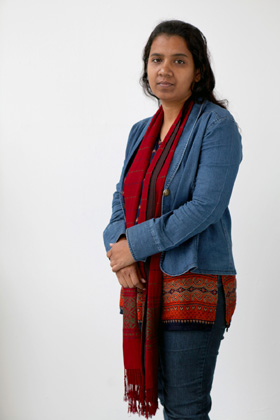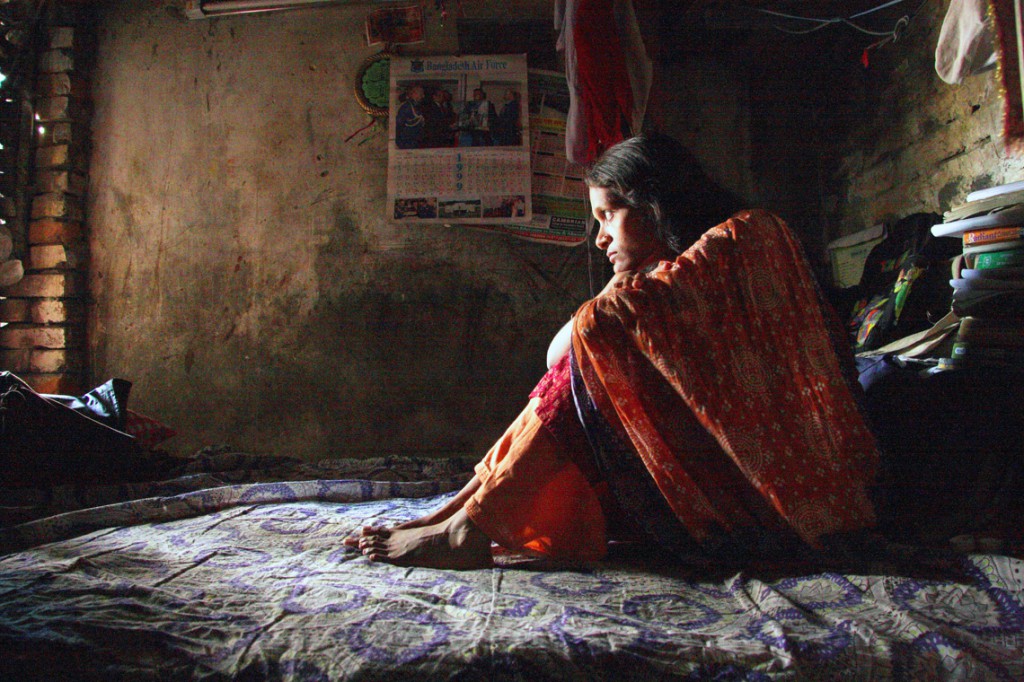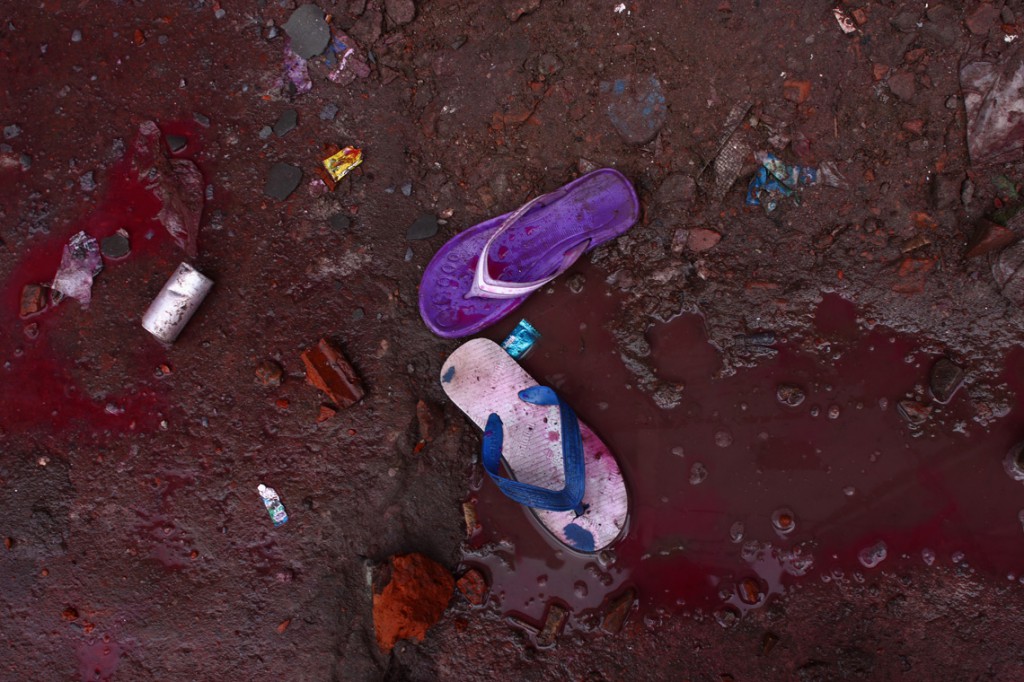Taslima Akhter
Introduction
I wanted to be an artist drawing and making handicrafts but my dream is now ruined by a sewing needle — Liza, a garment worker.
Dreaming of living a better life, millions of villagers gather in workers boarding houses in cities. Surrounding the garment industry many large workers’ boarding houses have come up in Bangladesh. Lija, Modhumala, Amjad are among them. They do not ask for much. They don’t have any dream to own a car, a house or any other luxuries. They want only coarse rice-cloth and a place to stay, a roof over their heads.
Large barracks for workers in the garment industries have grown in Dhaka, Savar, Gajipur, Narayngonj, Chittagong and many areas of Bangladesh, based on the garment industries. With nearly 4 million workers, the garment industry is the largest foreign revenue earning sector earning 76 percent of foreign currency since the 1980s. 80% of garment workers are women.
Workers toil from dawn to dusk over four years from 2006 to 2010 on a minimum wage BDT. 1662.50 Taka for a month (less than 25 US $). After December 2010 their new gross wage has become BDT 3000 (less than 45$), which is not sufficient for them to survive.. Now in 2012, workers are still struggling to increase their wage because it’s too difficult for them to survive on their current wages.
After national sectors like paper-jute and many other industries collapsed, garment became the largest industry. And the demand of increasing their minimum wage and working condition are the most important issue in workers’ movement.
All over the country workers frequently organize protests against their wage scale and working conditions. They become frustrated and angry and their anger often bursts out through protest. When workers protest they often faces fire, bullets, batons and arrest. They lose their lives when fires break out in unsafe factory workplaces.
This photo essay portrays the contrast between the dream and reality of millions of workers especially the women in the garment industry who are the biggest source of wealth in Bangladesh.
Interview
Karen Knorr (Professor of Photography at University for the Creative Arts, Farnham) interviews Taslima Akhter Lima (Magnum Foundation Scholar in 2011).
In 2011 Karen Knorr travelled, with Geoff Blight , her partner to participate in the events surrounding Chobi Mela VI , the international photography festival in Dhaka, Bangladesh. She was representing Puerto Rico and her work India Song, was exhibited at Lichutola faculty of Fine Arts at Dhaka University. – this is where she first encountered the inspiring work of Taslima Akhter Lima.
This interview made during May / June 2012, marks an exchange between two women photographers from very different backgrounds and cultures, designed to open up understanding of how practices develop in different contexts. New work by Taslima Akhter projected at Chobi Mela concerned with the poor working conditions and pay for garment workers in Bangladesh is discussed.
Karen Knorr: Taslima, you have recently travelled from Dhaka, Bangladesh in 2011 to complete a six-week course at New York University’s Tisch School of the Arts. The course was a part of a Magnum Foundation scholarship that you won in 2010. You had difficulties obtaining a visa in time and you took the course this year. Tell me about your journey, the course, where you have travelled, what your impressions were.
Taslima Akhter: No doubt it’s a great occasion for me that I attended Human Rights and Photography course at New York University in 2011 as a Magnum Scholar. This year I have come to stay with my sister in London and have the opportunity to do an internship with Magnum UK. I won the scholarship for the South Asian region in 2010 but ran into difficulties processing the visa for the US, which meant I couldn’t attend the course at that time. But I’m lucky that Magnum didn’t cancel my scholarship and I attended NYU in 2011.
In 2011, when I attended NYU for the photography course it was really a totally new experience for me. As an overseas visitor, a person from different culture (Bangladesh), I just immersed myself into a very different culture. Simultaneously, I tried to learn from the course enthusiastically. I was very excited about the course and teachers, as it gave me a chance to learn from teachers like Susan Meiselas (President of Magnum Foundation) and Fred Ritchen (Professor of NYU). I learned photographic practice from them and it was a formative and inspiring experience.
The Human Rights and Photography course taught us how to put together a photo essay, editing, human rights advocacy issues, and presentation strategy etc. We produced a photo essay during the course, and my subject was a single mother who had lived for13 years in USA having emigrated from Bangladesh. Unlike my own country, it is not so easy to work and get free access to different places in a foreign country! Coming from a very different culture-language background, I have tried to push my self to learn as much as possible. I hope I acquired strategies on how to work internationally and how to produce strong photo essay including different ways of presenting the photographic work. During the course at New York University, Magnum also introduced us to many photo editors, photo agencies and publishers. We travelled to Washington to see the Look3 photo festival. But my best learning experience was that I learnt how to push the limits beyond my usual comfort zone. One can learn much more by leaving one’s comfort zone.
Recently I have been traveling to other countries for my photography. In 2009, I traveled to Norway with a group of classmates and my teacher Hasib Zakaria from Pathshala (South Asian Media Academy). I participated in Nordic Light photo festival in Norway. In 2012, I went to India to attend an International Workshop and to Germany with an invitation of an organization ‘Courage’ who curated my photo exhibition and talked about my work experience. Now I am in the UK and have completed internship with Magnum UK . I have an incredible opportunity to research many photographers’ work in Magnum, UK. All these experiences will be of great value to my career as an activist- photographer.
KK: I saw your work Life and Struggles of the Garment Workers for the fist time projected at The Chobi Mela VI Dreams photography Festival in Dhaka in February 2011. It was accompanied by music, which was very powerful and dramatic. The work was also published as a photo story in the New York Times last year. How did the project begin? How is this work both personal and political?
TA: I am glad that through Chobi Mela I was able to introduce our garment workers issue to a very big and serious international audience. Without any deep personal feeling, relation or connection I can’t take my camera to work on just any topic. When any of my students asks me about the selection of their work for their photo story, I always suggest that they work on a topic, which they either love or hate strongly, and that they find out and explore the reason behind these feelings. This is how I work and the exploration of strong feelings is part of my work process.
In 2008, as a student of photojournalism at Pathshala I choose the topic ‘life of garment workers’ for my year long project and I began to work on it.
I had chosen garment workers to do my project because I feel that the garment worker’s movement is one of the important issues of our country. I think the problems of workers today are not only their own problem, but it is a matter for every citizen. The garment workers issue is related to questions of the democratic transition of our country, the rights of citizens and gender issues. So it is not only the garment workers issue, it is also on my agenda and at times it is a political and very personal issue to me.
KK: I am also very interested in the meaning of these photographs as a series presented in different contexts (newspaper, and projection). You transform the work by the way you edit it. Tell me about how you edited the work for the New York Times and for your projection. How do you intend to use these images in the future?
TA: Actually for the New York Times or any other newspaper, when they published my work they edited my work because of limited space and other things. But when I do my personal exhibition or projection, I make my own decisions on how to edit my work. For last four years I worked on this topic (garment workers) and my edit is evolving gradually as the work progresses. I tried to show their struggle for minimum wage, living condition and their struggle to over come it. I don’t want to show only workers problem and crisis, and I have tried to show their daily life joy-sorrows and the relation with state and the strength to over come their problems. I never want to make my work as a ‘fund raising’ project by showing workers’ issues only.
KK: You are an activist photographer. Do you think photography can change things? How did you become an activist?
TA: Photography can change things – I do believe it strongly. Like film, painting and many other media, photography has it’s own language and methods of communication. I think a photographer cannot only live from photography but can also raise her/his voice, views and thoughts through this medium. The camera is just an instrument but the photographer behind it is the one with ideas and feelings to create photographs representing her own ideology, through which people can take initiatives to change things.
The search for a different life, a different taste for life, a dignified life, a life without discrimination or prejudice — attracted me to politics and activism. I was born in a very conservative and traditional family. As a woman, I observed and many discriminations and experienced restrictions from my own family and obviously from society too, which made me to think about changing my life.
When I was a first year student of University of Dhaka, my friends were involved in leftist organization and I gradually got involved. I read Maxim Gorky’s book Mother which influenced me a lot about politics. I became a member of student organization in 1994, and later during my student life I became the president of the Bangladesh student Federation in Dhaka University. After completing my MPhil from Dhaka University, I graduated in photojournalism from Pathshala, South Asian Media Academy. Now I am involved with women and workers’ associations. I believe photography is also a part of my activism and I also believe that there is no innocent and neutral position for any photographer or journalist or even for any human being.
KK: You teach Visual Anthropology at the Media Academy, Dhaka. In the United Kingdom there are many photography undergraduate degree courses now where one can study photography theory and much as photography as a hands on practice. Yet there is a lot of misunderstanding and even resistance about the role of theory in photography. What is your opinion of the role of theory in photography?
TA: In our country we also go through this kind of misunderstanding, resistance and experiences about theory and practice of photography. I teach Visual Anthropology and photography at Pathshala (South Asian Media Academy). Actually, I not only teach but also learn through this course and enjoy it very much. As a teacher, I always tell students in order to find out the answers is why they choose particular topics to photograph and to also to explore their own relation with the photographer and the topic. Everybody should be clear within himself/herself about these matters.
When any photographer gives a statement with his/ her photos, I think it can never be neutral, some how it comes through their own world view/position. This position is related to her/his thoughts, views and theories; and theory emerges through practice. Sometimes people say, ‘I took photograph because I love it and like it but I don’t know why I love it’. With due respect, I want to say basically this is a simple short-cut answer. ‘I like it so I do it’—I could never satisfy myself with this reply. I think I have to know the reason behind the photograph.
I think we are living in a capitalist economy where capitalism wants to commodify every thing and every human being. In this world of commodity production, photographers have also become a product and their work also has a commodity value. In a competitive market, photographers are constantly running after hot issues to photograph, which they can sell as photos, win prizes, and earn money and survive. In pursuit of fame and money they often ignore the vital question about why they are doing this. This may not be their fault but they are trapped in the system.
I am not against recognitions or prizes, off course I think that when I submit my work in national or international region it gives me space to show my work to others and any recognition inspire people. Also criticism of others helps to shape ideas. But I do not agree with working only to survive or only to get prizes without asking why or researching the relation with photographers have with their own work.
I think without any ideological and theoretical viewpoint one can’t make his/her work strong.
KK: Are you continuing to make-work on women’s lives in Bangladesh? Have you worked on other projects? How do you see your work developing in the future?
TA: I prefer to work on gender-environmental-cultural issues and the problem of social discrimination. I continue to work on garment workers lives & struggles. I recently worked on life and practice of Lalon devotees. In New York, I worked on the life of a single mother. This year in February, I started working on Aftermath of Nandigram Massacre in 2007 which addresses and challenges the requisition of land by the multinational companies. I continue to work on women’s life and the struggle, and also against the land requisition by multi national companies.
I would love to publish my work on the garment worker’s life and struggle as a book and I intend on organizing an exhibition of the photographs inside garment workers quarters, near the factory area. I am also interested making works collectively with my other photographer friends as I believe that photography can play a strong role by changing things in society and that this can also be a collective endeavor.
- In 2007 the West Bengal government decided to allow the global Salim Group to set up a chemical hub at Nandigram under the special economic zone policy originally put into place to encourage development. This led to resistance by the villagers resulting in clashes with the police that left 14 villagers dead, and accusations of police brutality.
In the panchayat or local self-government elections held in May 2008 in West Bengal the Communist Party of India (Marxist),who had been in power in this region for 30 years, and its left front allies were defeated in Nandigram and adjoining areas by the Trinamool Congress-SUCI alliance.
Many Indian Intellectuals took strong position against the government arising international awareness. See this article.
Biography

Taslima Akhter, born in Dhaka in 1974, graduated from Pathshala (South Asian Media Academy) with a degree in Photojournalism.
Taslima Akhter currently works as photography tutor at Pathsala South Media Academy.
Akhter’sr photo story ‘The Life and Practice of Lalon devotees’ was exhibited in Nordic Light Photo Festival in Norway in 2009. In 2010, she was selected for the Magnum Foundation scholarship in photography from South Asian region. In 2011 she participated the summer course on human rights and photography at New York University. In 2010, she won third prize for documentary photography: The Julia Margaret Cameron Award for her work on ‘The Life and Struggle of Garment Workers’ which was selected for Angkor Photo Festival 2010 in Cambodia and exhibited in Bangladesh during the garment workers’ movement’s strike actions for increasing their minimum wage. Taslima completed her Masters and M. Phil from the department of Public Administration in University of Dhaka in 2007 and became involved in student politics during her student life, she became the president of Bangladesh Student Federation. She continues her involvement with worker and women’s organization as an activist. Considering photography as a part of her political work, she chooses to work on gender-environmental-cultural issues and the issues of social discrimination.
Taslima Akhter completed her 4 week internship with Magnum Uk in July 2012 and her seminal work The Life And Struggles of Garment Workers will be presented in the 4th edition of the AnthropoGraphia Human Rights Through Visual Storytelling exhibition.















